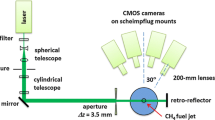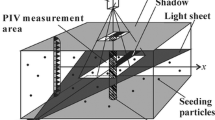Abstract
This paper investigates the use of high-power light-emitting diode (LED) illumination for tomographic particle image velocimetry (PIV) as an alternative to traditional laser-based illumination. Modern solid-state LED devices can provide averaged radiant power in excess of 10 W and by operating the LED with short high current pulses theoretical pulse energies up to several tens of mJ can be achieved. In the present work, a custom-built drive circuit is used to drive a Luminus PT-120 high-power LED at pulsed currents of up to 150 A and 1 μs duration. Volumetric illumination is achieved by directly projecting the LED into the flow to produce a measurement volume of ≈3–4 times the size of the LED die. The feasibility of the volumetric LED illumination is assessed by performing tomographic PIV of homogenous, grid-generated turbulence. Two types of LEDs are investigated, and the results are compared with measurements of the same flow using pulsed Nd:YAG laser illumination and DNS data of homogeneous isotropic turbulence. The quality of the results is similar for both investigated LEDs with no significant difference between the LED and Nd:YAG illumination. Compared with the DNS, some differences are observed in the power spectra and the probability distributions of the fluctuating velocity and velocity gradients. These differences are attributed to the limited spatial resolution of the experiments and noise introduced during the tomographic reconstruction (i.e. ghost particles). The uncertainty in the velocity measurements associated with the LED illumination is estimated to approximately 0.2–0.3 pixel for both LEDs, which compares favourably with similar tomographic PIV measurements of turbulent flows. In conclusion, the proposed high-power, pulsed LED volume illumination provides accurate and reliable tomographic PIV measurements in water and presents a promising technique for flow diagnostics and velocimetry.















Similar content being viewed by others
References
Adrian RJ, Westerweel J (2010) Particle image velocimetry. Cambridge University Press, Cambridge
Agui J, Jimenes J (1987) On the performance of particle tracking. J Fluid Mech 185:447–468
Atkinson C, Coudert S, Foucaut J-M, Stanislas M, Soria J (2011) The accuracy of tomographic particle image velocimetry for measurements of a turbulent boundary layer. Exp Fluids 50:1031–1056
Atkinson C, Soria J (2009) An efficient simultaneous reconstruction technique for tomographic particle image velocimetry. Exp Fluids 47:553–568
Broeder D, Sommerfeld M (2007) Planar shadow image velocimetry for the analysis of the hydrodynamics in bubbly flows. Meas Sci Technol 8:2513–2528
Buchmann NA, Atkinson C, Jermy MC, Soria J (2011a) Tomographic particle image velocimetry investigation of the flow in a modeled human carotid artery bifurcation. Exp Fluids 50:1131–1151
Buchmann NA, Atkinson C, Soria J (2010a) Tomographic and stereoscopic PIV measurements of gridgenerated homogeneous turbulence. In: 15th International symposium on applications of laser techniques to fluid mechanics, Lisbon, Portugal
Buchmann NA, Mitchell D, Ingvorsen KM, Honnery D, Soria J (2011b) High spatial resolution imaging of a supersonic underexpanded jet impinging on a flat plate. In: Sixth australian conference on laser diagnostics in fluid mechanics and combustion, Canberra, Australia
Buchmann NA, Willert C, Soria J (2010b) Pulsed, high-power LED volume illumination for tomographic particle image velocimetry. In: 17th australasian fluid mechanics conference, Auckland, New Zealand
Chetelat O, Kim KC (2002) Miniature particle image velocimetry system with LED in-line illumination. Meas Sci Technol 13:1006–1013
Elsinga GE, Scarano F, Wieneke B, van Oudheusden BW (2006) Tomographic particle image velocimetry. Exp Fluids 41:933–947
Elsinga GE, Westerweel J, Scarano F, Novara M (2011) On the velocity of ghost particles and the bias errors in Tomographic-PIV. Exp Fluids 50:825–838
Estevadeordal J, Goss L (2005) PIV with LED: Particle shadow velocimetry (PSV). In: 43rd AIAA aerospace sciences meeting and exhibit, pp 12355–12364
Foucaut JM, Carlier J, Stanislas M (2004) PIV optimization for the study of turbulent flow using spectral analysis. Meas Sci Technol 15:1046–1058
Ganapathisubramani B, Lakshminarasimhan K, Clemens NT (2007) Determination of complete velocity gradient tensor by using cinematographic stereoscopic PIV in a turbulent jet. Exp Fluids 42:923–939
Hagsaeter SM, Westergaard CH, Bruus H, Kutter JP (2008) Investigations on LED illumination for micro-PIV including a novel front-lit configuration. Exp Fluids 44:211–219
Hargather MJ, Lawson MJ, Settle GS, Weinstein LM, Gogineni S (2002) Focusing-Schlieren PIV measurements of a supersonic turbulent boundary layer. In: 47th AIAA aerospace sciences meeting, Florida, Orlando
Jimenez J (1998) Turbulent velocity fluctuations need not be gaussian. J Fluid Mech 376:139–147
Klinner J, Willert C (2012) Tomographic shadowgraphy for three-dimensional reconstruction of instantaneous spray distributions. Exp Fluids doi:10.1007/s00348-012-1308-2
Kühn M, Ehrenfried K, Bosbach J, Wagner C (2011) Large-scale tomographic particle image velocimetry using helium-filled soap bubbles. Exp Fluids 50:929–948
Kühn M, Ehrenfried K, Bosbach J, Wagner C (2012) Large-scale tomographic PIV in forced and mixed convection using a parallel SMART version. Exp Fluids doi:10.1007/s00348-012-1301-9
Li Y, Perlman E, Wan M, Yang Y, Burns R, Meneveau C, Burns R, Chen S, Szalay A, Eyink G (2008) A public turbulence database cluster and applications to study lagrangian evolution of velocity increments in turbulence. J. Turbulence 9(31)
Lindken R, Merzkirch W (2002) A novel PIV technique for measurements in multiphase flows and its application to two-phase bubbly flows. Exp Fluids 33:814–825
Luminus (2009) Product Data Sheet, PhlatLight PT120 Projection Chipset. Luminus Devices Inc
Scarano F, Elsinga GE, Bocci E, van Oudheusden BW (2006) Investigation of 3-D coherent structures in the turbulent cylinder wake using tomo-PIV. In: 13th international symposium on applications of laser techniques to fluid mechanics, Lisbon, Portugal
Soloff SM, Adrian RJ, Liu ZC (1997) Distortion compensation for generalized stereoscopic particle image velocimetry. Meas Sci Technol 8:1441–1454
Soria J (1996) An investigation of the near wake of a circular cylinder using a video-based digital cross-correlation particle image velocimetry technique. Exp Thermal Fluid Sci 12:221–233
Wieneke B (2008) Volume self-calibration for 3D particle image velocimetry. Exp Fluids 45:549–556
Wieneke B, Taylor S (2006) Fat-sheet PIV with computation of full 3D-strain tensor using tomographic reconstruction. In: 13th International symposium on applications of laser techniques to fluid mechanics, Lisbon, Portugal
Willert C, Moessner S, Klinner J (2009) Pulsed operation of high power light emitting diodes for flow velocimetry. In: 8th international symposium on particle image velocimetry, Melbourne, Australia
Willert C, Stasicki B, Klinner J, Moessner S (2010) Pulsed operation of high-power light emitting diodes for imaging flow velocimetry. Meas Sci Technol 21:075402
Willert CE, Mitchell DM, Soria J (2012) An assessment of high-power light-emitting diodes for high frame rate schlieren imaging. Exp Fluids doi:10.1007/s00348-012-1297-1
Worth N, Nickels T (2008) Acceleration of Tomo-PIV by estimating the initial volume intensity distribution. Exp Fluids 45:847–856
Worth NA, Nickels TB, Swaminathan N (2010) A tomographic PIV resolution study based on homogeneous isotropic turbulence dns data. Exp Fluids 49:637–656
Acknowledgments
This research was supported under the Australian Research Council’s Discovery Project funding scheme (DP1096474).
Author information
Authors and Affiliations
Corresponding author
Appendix
Appendix
The intensity I of the recorded particle images shown in Figs. 7 and 16 can be expressed as follows
where I n is the noise level of the CCD sensor, I f the intensity contribution due to flair, reflections and out-of-focus particles and I p the particle image intensity. The noise level I n can be determined by recording a black image or from the camera specifications. The background intensity I b = I n + I f is assumed to follow a normal distribution and is obtained by fitting a Gaussian model to the left-hand side of the intensity pdf. The particle image contribution is then obtained as I p = I − I b .
From Eq. 3, the following signal-to-noise ratios can be defined.
where \(\langle \rangle\) denotes mean intensities. As the strength of the illumination increases both I f and I p increase proportionally and SNR i remains nearly constant. The definition of SNR i is equivalent to that of image contrast in Adrian and Westerweel (2010), which is independent of the illumination and promotional to the inverse of the seeding density. For the present case, SNR i ≈ 2 irrespective of pulse width or drive current. The definition of SNR s is more suitable to characterise the effect of the illumination quality; however, it ignores the contribution of the background intensity. By combining the two definitions, the signal-to-noise ratio expressed as the difference between the particle and background intensity over the noise level is defined as
Note, in the extreme where the particle image intensity tends to zero (i.e. low light conditions), the SNR also approaches zero.
Rights and permissions
About this article
Cite this article
Buchmann, N.A., Willert, C.E. & Soria, J. Pulsed, high-power LED illumination for tomographic particle image velocimetry. Exp Fluids 53, 1545–1560 (2012). https://doi.org/10.1007/s00348-012-1374-5
Received:
Revised:
Accepted:
Published:
Issue Date:
DOI: https://doi.org/10.1007/s00348-012-1374-5





